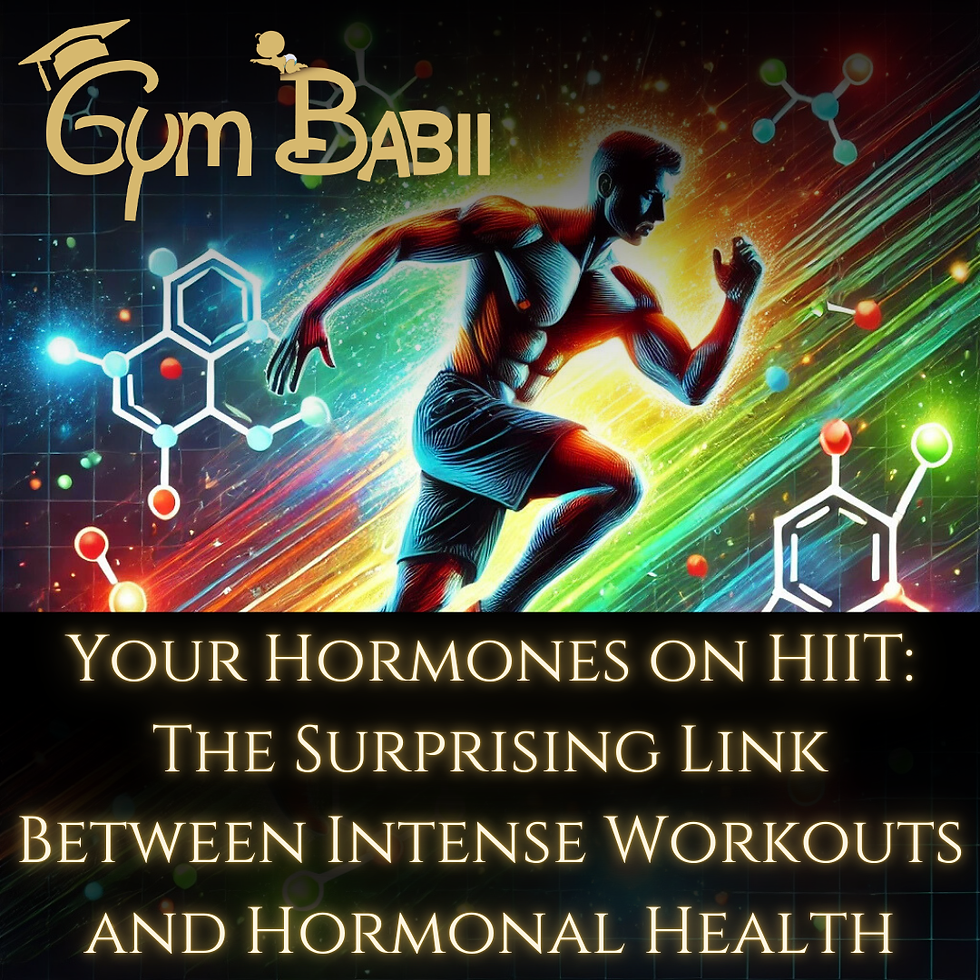Your Hormones on HIIT: The Surprising Link Between Intense Workouts and Hormonal Health
- Gym Babii Writing Team

- Nov 11, 2024
- 3 min read

Hey Growers & Learners,
In today’s article, we’re getting into Your Hormones on HIIT: The Surprising Link Between Intense Workouts and Hormonal Health. High-Intensity Interval Training (HIIT) isn’t just a calorie-burning powerhouse; it’s also a game-changer for your hormones. But how? And why should you care? Let’s explore the hormone-boosting benefits of HIIT and how this workout style can be a secret weapon for both fitness and overall health.
HIIT and Hormones: What’s the Connection?
When you do HIIT, you’re not just torching calories—you’re also igniting some serious hormonal responses. From boosting testosterone to helping manage cortisol levels, HIIT has a profound impact on the chemical messengers that control everything from your metabolism to your mood.
Key Players:
Testosterone: Known for its muscle-building powers, this hormone also helps with recovery and overall energy levels.
Growth Hormone: HIIT can boost this hormone, which is essential for muscle repair, fat metabolism, and overall cellular health.
Cortisol: Often dubbed the “stress hormone,” cortisol helps your body manage intense exercise. HIIT can help optimize cortisol levels, so you stay in the sweet spot between stress and recovery.
How HIIT Impacts Testosterone Levels
Testosterone isn’t just for muscle-bound bodybuilders. It’s essential for anyone looking to boost strength, increase endurance, and recover faster. HIIT workouts are especially effective for naturally boosting testosterone because they push your body to its limits, signaling it to produce more of this vital hormone.
Tips for Maximizing Testosterone:
Keep It Intense: Short, high-intensity intervals followed by brief recovery periods work best.
Add Strength Moves: Incorporating bodyweight exercises like push-ups, squats, or kettlebell swings helps stimulate testosterone production even more.
HIIT, Growth Hormone, and the “Afterburn Effect”
HIIT isn’t just great for testosterone—it’s also fantastic for boosting growth hormone. This hormone plays a key role in muscle repair, fat metabolism, and overall health. The “afterburn effect” is what really sets HIIT apart. Because it’s so intense, your body continues to burn calories and produce growth hormone long after you’ve finished your workout.
Pro Tips:
Focus on Recovery: Growth hormone is released during rest, so make sure you’re getting plenty of sleep.
Mix Up Your Intervals: Try different interval lengths to keep your body guessing and maximize hormone release.
Cortisol: The Good, the Bad, and the HIIT-Optimized
Cortisol gets a bad rap, but it’s actually an essential part of your body’s stress response. Too much cortisol can lead to muscle breakdown and fat storage, but HIIT can help keep cortisol levels in check by optimizing the timing and intensity of its release.
How to Manage Cortisol with HIIT:
Keep Sessions Short: Too much HIIT can lead to high cortisol levels, so aim for 20-30 minutes max.
Take Rest Days: Your body needs time to recover and keep cortisol levels balanced, so schedule in some active recovery days.
How to Optimize HIIT for Your Hormones
HIIT can be a powerful tool for optimizing your hormones, but it’s all about finding the right balance. Listen to your body, and don’t be afraid to adjust your intensity or take an extra rest day if you need it.
Tips for Hormone-Optimized HIIT:
Go Hard, Then Go Home: Aim for maximum intensity during your intervals, but keep your total workout time under control to prevent burnout.
Cycle Your HIIT: Rotate between high-intensity days and lower-intensity recovery days to keep your hormones in balance.
Stay Hydrated: Dehydration can affect hormone levels, so drink plenty of water before, during, and after your workouts.
You're not just improving your present—you’re safeguarding your future. Stay connected, keep growing and learning. For more check out the home of the central intelligence hub of stress-free fitness and parenting at www.gymbabii.com where you can find gifts, challenges, updates, and more keys and hacks.
No Stress. Stress Is The Enemy.
Over and Out, The Gym Babii Team




Comments